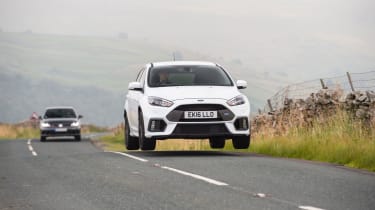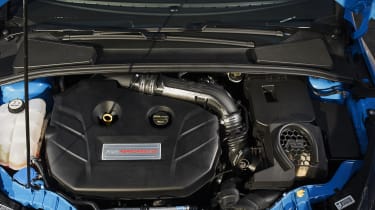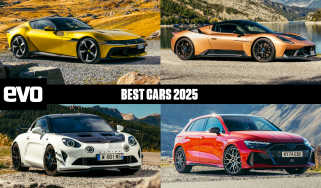Ford Focus RS review – engine and gearbox
The Focus RS impresses with strong performance and great handling
The latest generation Focus RS no longer has the warbling in-line 5-cylinder engine that bestowed the MK2 with huge amounts of charm. Instead it shares the 2.3ltr Ecoboost engine with the European entry-level Mustang. That is no bad thing, the 2261cc 4-cylinder turbo does a good job of making the big Mustang a reasonably fast car, even if the giant V8 suits its character even more.
The engine isn’t left untouched in the RS, though. It has a different turbo to deal with a higher flow of gasses, the material that makes the head casting and the piston liners is changed, and the size of the intercooler, radiator and oil cooler have been increased. The intercooler is so big that, when first tested, it cooled the air to the point water vapour started to appear in the intake. Since then it's had to be blanked off to reduce how efficient it is, but that does mean there’s plenty of scope for more power, at least where the intercooler is concerned.
The engine itself feels strong and eager. It doesn’t have the most linear power delivery, a definite boost is felt at 4000rpm and then again at 5000rpm. But, it feels like it wants to rev right to its limiter, even if the noise it makes isn’t exactly scintillating. Ford have tried hard to make it sound more impressive than most 4-cylinder turbo engines on the market. And although they’ve not failed, it’s really only when the exhaust pops and crackles on overrun when the engine makes anything but an ordinary noise.
More reviews
Group tests
In-depth reviews
- Used Ford Focus ST (Mk4, 2019-2025) review – Ford has killed its last remaining hot hatch
- Ford Focus ST review – engine, gearbox and technical specs
Reviews
- ZeroNine Ford Focus ST review – Ferrari 599 pulling power in a hatchback
- Used Ford Focus ST Edition (Mk4, 2021 - 2025) review – a Honda Civic Type R rival for £20k
- Ford Focus 2025 review – is Ford killing its best car?
- Used Ford Focus RS500 (Mk2, 2010 - 2011): review, specs and buying guide for the original hyperhatch
It's worth noting that Milltek also do an aftermarket exhaust for the RS which adds even more over the top crackles and pops. You can hear it on our Instagram page here.
The gearbox itself isn’t technically very impressive, but it is competent and the shift is clear, quick and easy. The rest of the drivetrain is worth going into more depth.
Much has been said about the Focus RS’s four-wheel drive system, particularly its Drift mode. So how does it actually work?
The front axle is much like that of a conventional front wheel drive car. There’s an open, non-locking differential that distributes torque to the front wheels and allows each wheel to rotate at a different speed. So far, so ordinary.
As well as the front driveshafts the diff also rotates a propshaft that sends torque to the rear axle. However, the propshaft, unlike the front driveshafts, is not sharing torque with anything else so is permanently being turned. This propshaft turns a pinion and then a crownwheel within a rear diff housing. Just as the propshaft is being continually turned, so is the crownwheel and pinion.
>Read the best hot hatches on sale today
It’s the rear differential where things get interesting. Rather than a conventional open diff, or even an LSD, there is no gears other than the permanently driven crownwheel and pinion. This alone sounds like a recipe for disaster; a 100% locked rear diff that will cause catastrophic understeer and ludicrous tyrewear. However, instead of allowing the rear wheels to turn at different speeds by using gears there are two clutch packs, one on each driveshaft that can fully open and allow each rear wheel to spin independently.
When both of the clutch packs on the rear axle are open, and no torque is being sent to either rear wheel, the RS is essentially a front wheel drive car.
As the propshaft is being constantly driven, as soon as the clutch packs in the rear axle begin to close they immediately send torque to the rear wheels. And, as each of the clutch packs can work independently of each other, and vary the amount of torque they distribute almost instantly across the axle, they can make huge changes to how the car behaves.
Ford have said that, with the factory RS’s 4WD control system, they have seen up to 70% of the torque being sent to just one rear wheel. With the car in Drift mode, the system can send huge amounts of torque to the outside rear wheel to induce an exaggerated yaw movement to put the car into a slide. The rear diff can then vary the torque across the rear axle to maintain a slide as the driver keeps their foot pinned.
What’s more, the rear axle is geared 2% quicker than the front. So every time either of the rear wheels is engaged, the back is trying to overtake the front. The over-speed rear amplifies the already naturally agile rear axle.





